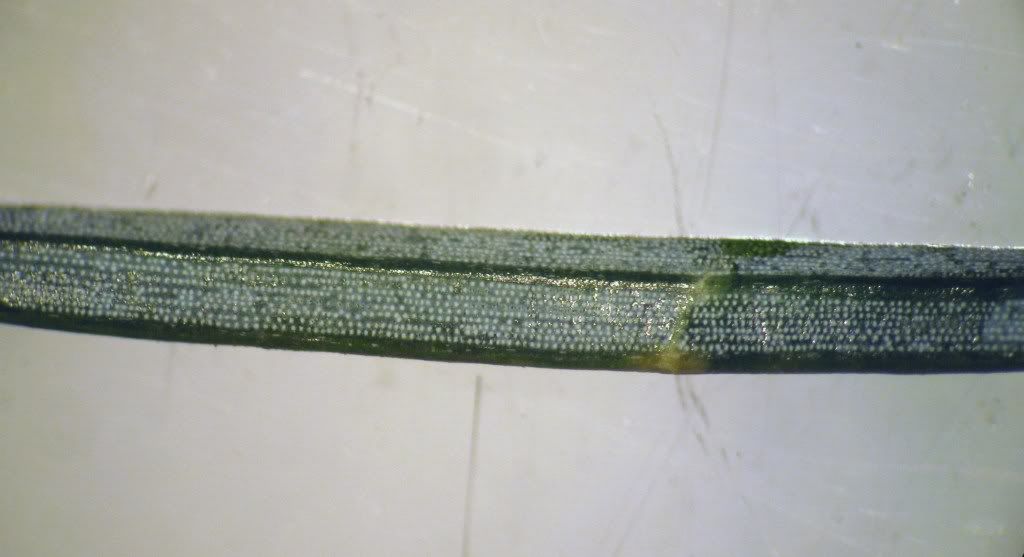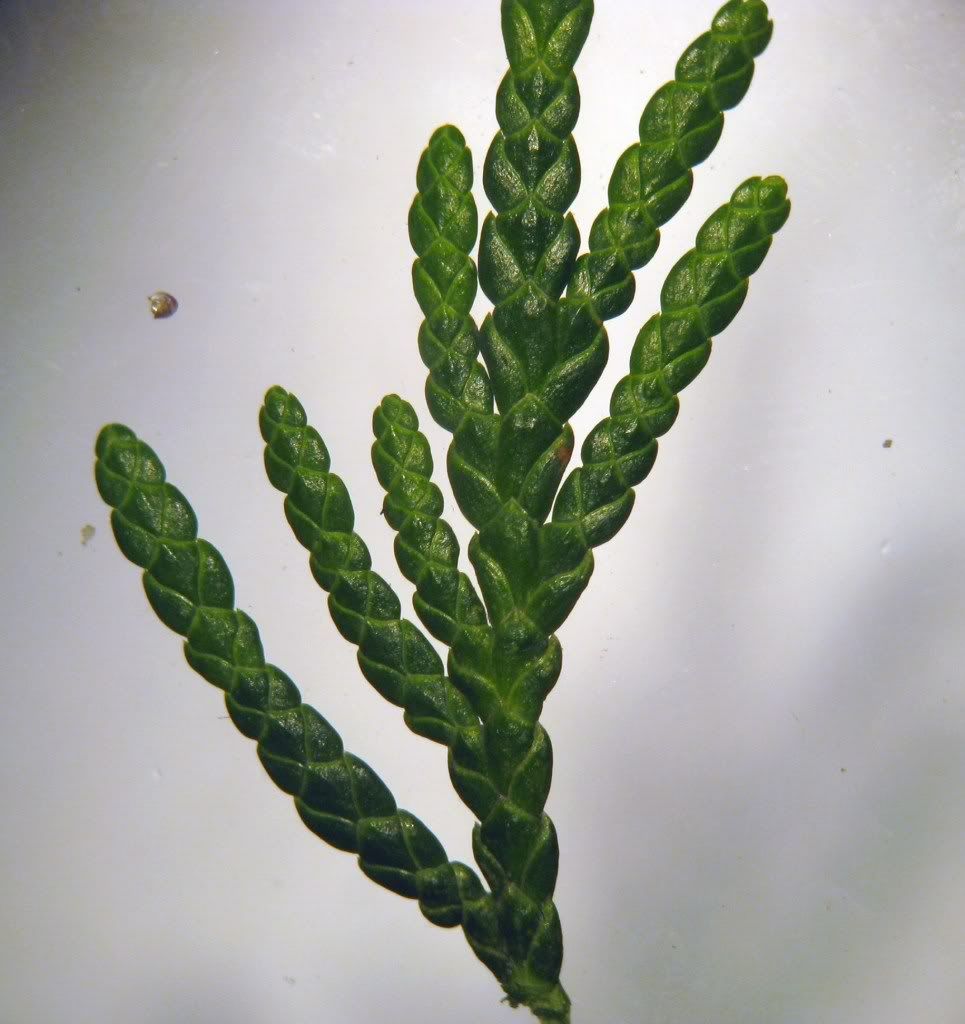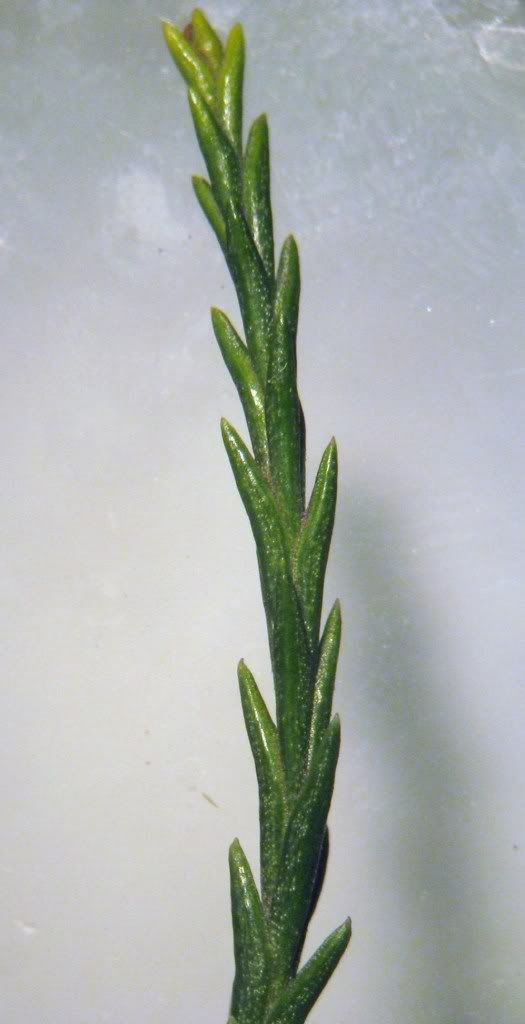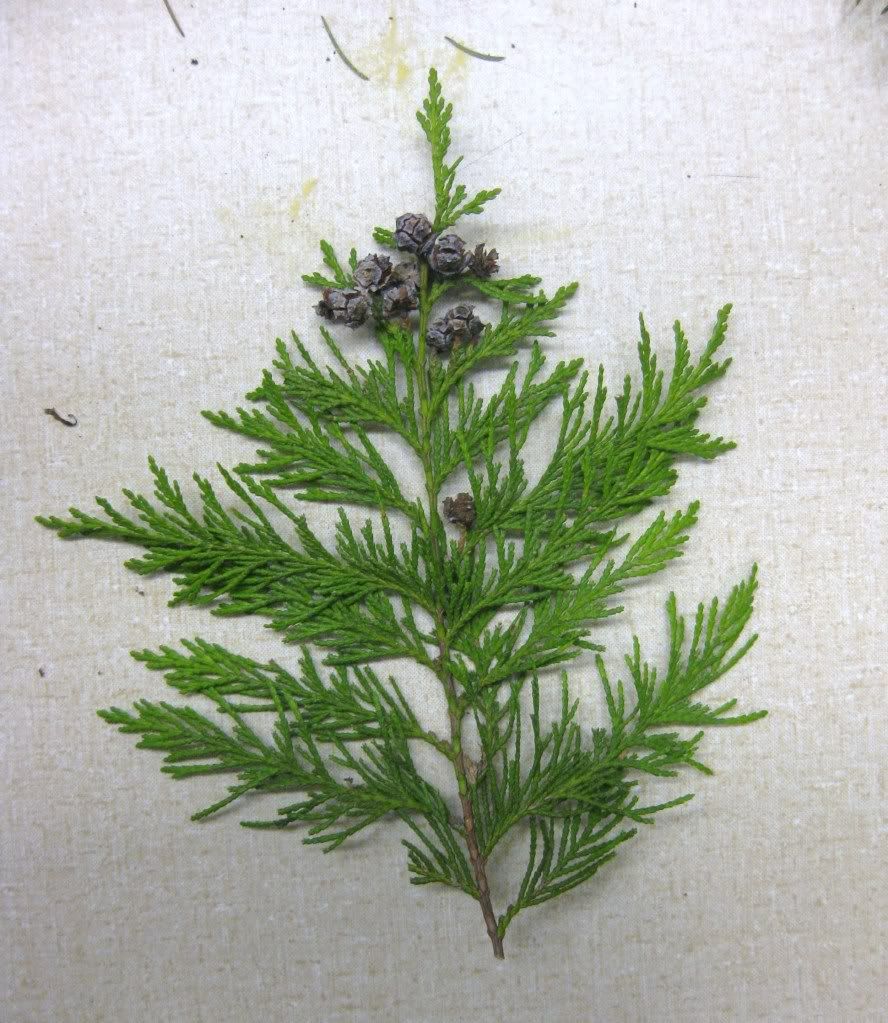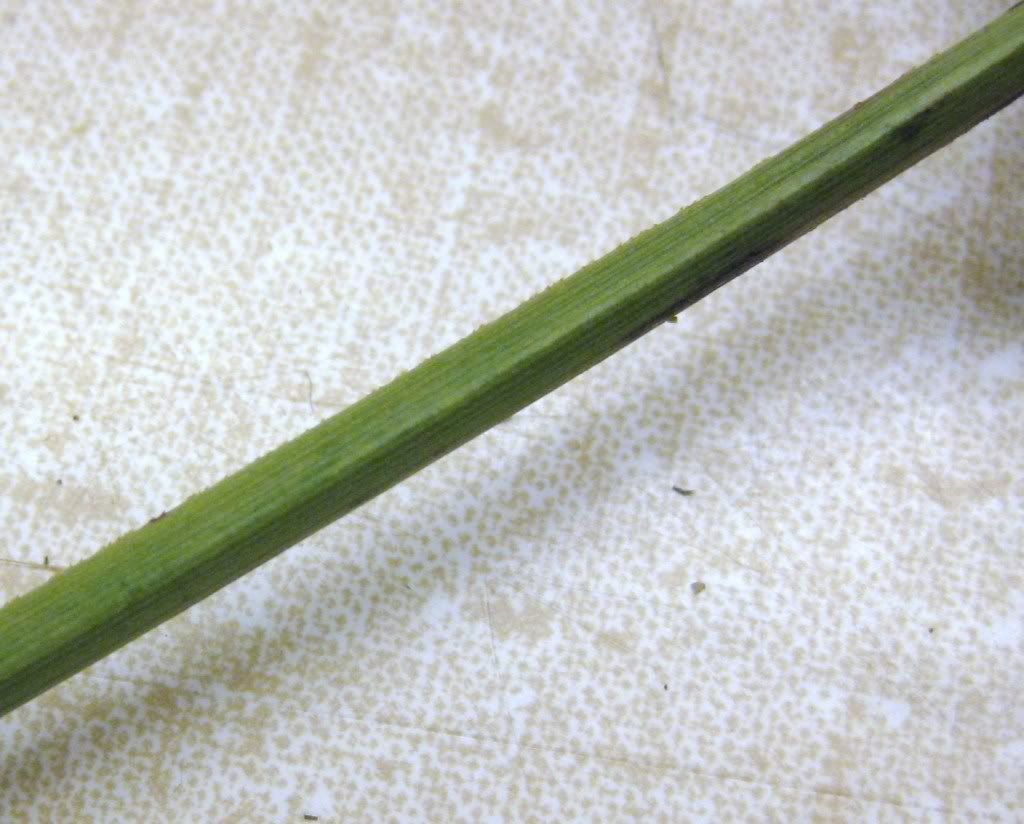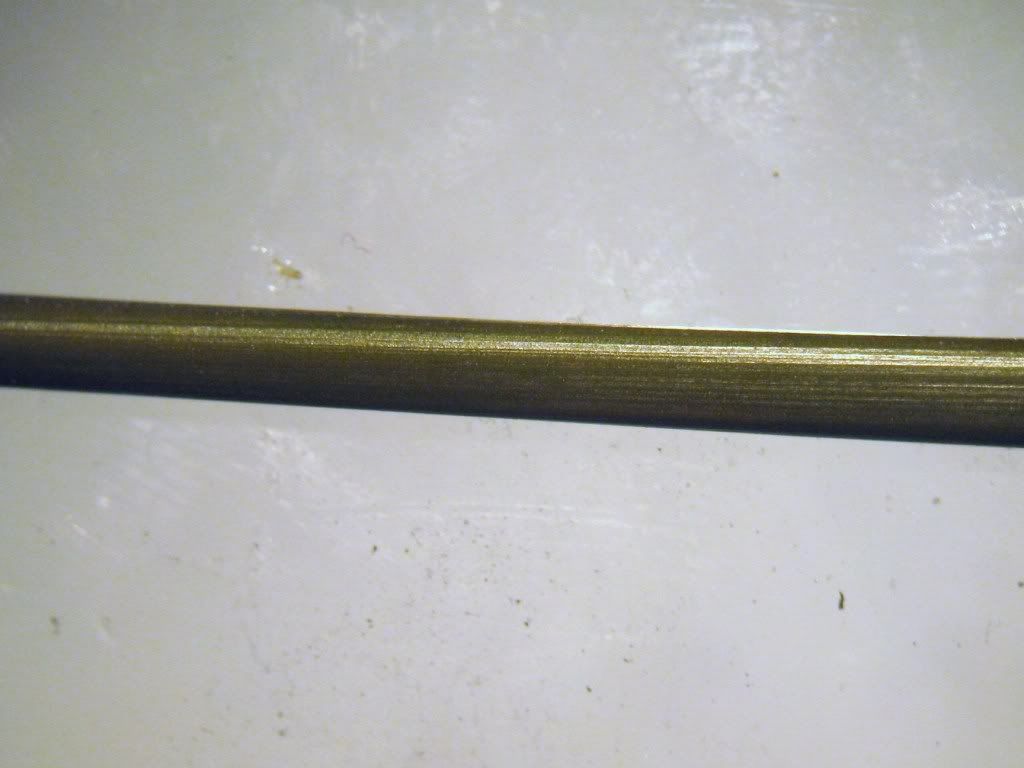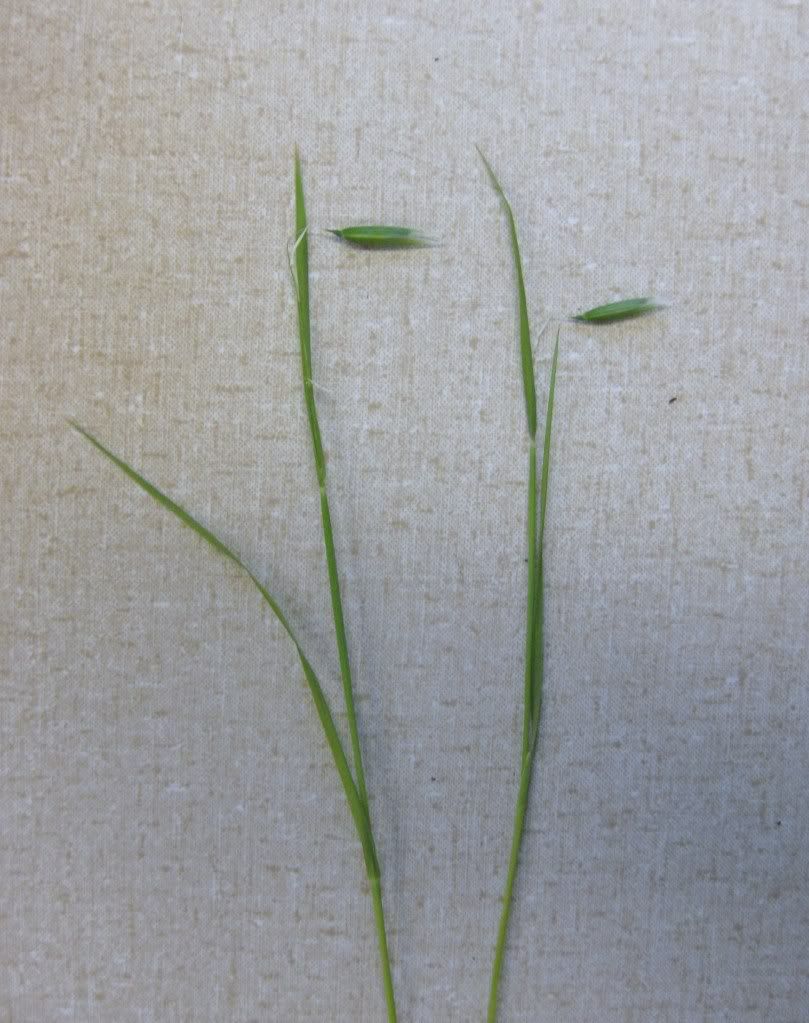Coniferales (conifers)
---
A leafy branch of Picea (spruce).
These woody projections are persistent leaf bases or sterigmata. It is the remains of leaves after they have fallen.
The underside of a Picea needle. Note the whitish lines of stomates, which are pores used for gas exchange.
---
A leafy branch of Abies (fir). The leaves are attached spirally but they twist to either side to form a uniform plane. This kind of arrangement is called distichous (2-ranked).
The leaf scars (remnants) are smooth (i.e. no sterigmata) and have a circular outline. This is characteristic of the Firs.
When the cones in Abies disintegrate, each scale falls off separately leaving the central axis attached to the branch (the long, thin structures above). Also note that the cones in firs are borne erect and attached on the topside of leafy branches.
---
The spiky branch of Pinus (pine). As our TAs mentioned in class, if you grip onto one of these it would not be pleasant.
The needles are grouped into bundles called fascicles. Each fascicle has a short branch at the base of the needles called short shoot. Instead of individual needles falling off, the short shoot falls off with all the needles still attached.
A pair of immature pine ovulate cones. The bracts are still intact but will fall of as these cones age.
This cone is more developed. Notice the bracts have disappeared.
An dead old cone that has done its job.
---
A branchlet of Thuja (cedar). Note its flatten morphology. When leaves senesce and is ready to fall off, the whole branchlet with the leaves is shed.
The leaves are these scale-like structures. They are in decussate arrangement meaning leaves are opposite and each pair is 90degrees to its adjacent pairs.
Male pollen cones of Cedrus sp. Note the multiple pollen sacs that are on spirally arranged scales.
The scales are flattened and imbricate in Thuja seed cones. They are also oppositely arranged, rather than spirally. Also note the small numbers of scales in each cone.
---
A branch of Sequoiadendron (redwood).
The leaves are awl-shaped (awl is a tool used to poke holes in tough materials such as leather). They have decurrent leaf bases (i.e. leaf bases that merge into the branch at an angle as oppose to perpendicularly attached).
---
A branch of Pseudotsuga (Douglas fir) with a female (seed) cone.
The spirally arranged leaves of Douglas fir.
The seed cone has spirally arranged ovulate cone scales which are modified branches. It also has 3-pronged bracts (modified leaves) that looks similar to the hind quarters of a mouse. The scales are imbricate meaning they are overlapping like shingles.
---
A branch of Chamaecyparis, who is a member of the Cupressaceae (Cypress family).
The scales in these cones are peltate (our TAs' description was a person holding umbrellas in multiple directions). In peltate scales the margins of the cone scales approach but do not touch adjacent cones (i.e. no overlapping).
Another member of the cypress family is Calocedrus (incense-cedar).
Pollen cones with pollen sacs are borne on the terminal scale tips.
---
A branch of Juniperus (juniper).
They have fleshy cones that do not open. These "berries" are used to flavor gin (alcohol, spirit).
This is all. I hope you have enjoyed viewing this blog as much as I have in making these postings.
Good luck on your final exams and have a fun-filled winter break!
-Midy Liou
---
A leafy branch of Picea (spruce).
These woody projections are persistent leaf bases or sterigmata. It is the remains of leaves after they have fallen.
The underside of a Picea needle. Note the whitish lines of stomates, which are pores used for gas exchange.
---
A leafy branch of Abies (fir). The leaves are attached spirally but they twist to either side to form a uniform plane. This kind of arrangement is called distichous (2-ranked).
The leaf scars (remnants) are smooth (i.e. no sterigmata) and have a circular outline. This is characteristic of the Firs.
When the cones in Abies disintegrate, each scale falls off separately leaving the central axis attached to the branch (the long, thin structures above). Also note that the cones in firs are borne erect and attached on the topside of leafy branches.
---
The spiky branch of Pinus (pine). As our TAs mentioned in class, if you grip onto one of these it would not be pleasant.
The needles are grouped into bundles called fascicles. Each fascicle has a short branch at the base of the needles called short shoot. Instead of individual needles falling off, the short shoot falls off with all the needles still attached.
A pair of immature pine ovulate cones. The bracts are still intact but will fall of as these cones age.
This cone is more developed. Notice the bracts have disappeared.
An dead old cone that has done its job.
---
A branchlet of Thuja (cedar). Note its flatten morphology. When leaves senesce and is ready to fall off, the whole branchlet with the leaves is shed.
The leaves are these scale-like structures. They are in decussate arrangement meaning leaves are opposite and each pair is 90degrees to its adjacent pairs.
Male pollen cones of Cedrus sp. Note the multiple pollen sacs that are on spirally arranged scales.
The scales are flattened and imbricate in Thuja seed cones. They are also oppositely arranged, rather than spirally. Also note the small numbers of scales in each cone.
---
A branch of Sequoiadendron (redwood).
The leaves are awl-shaped (awl is a tool used to poke holes in tough materials such as leather). They have decurrent leaf bases (i.e. leaf bases that merge into the branch at an angle as oppose to perpendicularly attached).
---
A branch of Pseudotsuga (Douglas fir) with a female (seed) cone.
The spirally arranged leaves of Douglas fir.
The seed cone has spirally arranged ovulate cone scales which are modified branches. It also has 3-pronged bracts (modified leaves) that looks similar to the hind quarters of a mouse. The scales are imbricate meaning they are overlapping like shingles.
---
A branch of Chamaecyparis, who is a member of the Cupressaceae (Cypress family).
The scales in these cones are peltate (our TAs' description was a person holding umbrellas in multiple directions). In peltate scales the margins of the cone scales approach but do not touch adjacent cones (i.e. no overlapping).
Another member of the cypress family is Calocedrus (incense-cedar).
Pollen cones with pollen sacs are borne on the terminal scale tips.
---
A branch of Juniperus (juniper).
They have fleshy cones that do not open. These "berries" are used to flavor gin (alcohol, spirit).
This is all. I hope you have enjoyed viewing this blog as much as I have in making these postings.
Good luck on your final exams and have a fun-filled winter break!
-Midy Liou


